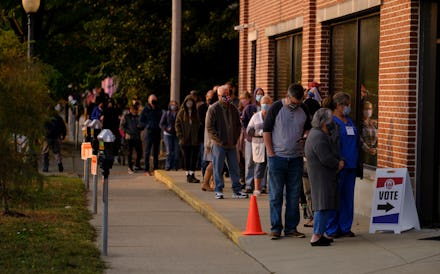Trump is blatantly trying to suppress the vote. Here’s how we fight back

Welcome to Ballot Barriers, Mic's weekly voting column for the 2020 election. Each week we'll explore the challenge of voting in an election year that's unlike any other.
During the presidential debate last week, Fox News anchor Chris Wallace asked President Trump point-blank if he would condemn white supremacists and direct them to “stand down” at Black Lives Matter protests. Trump deflected and instead blamed the left-wing movement antifa for violent activity. He then boldly instructed the Proud Boys, a far-right militia group, to “stand back and stand by,” and later encouraged his supporters to go to the polls and “watch very carefully, because that's what has to happen. I am urging them to do it.”
Trump’s call for his supporters, and perhaps a white supremacist hate group, to monitor polls, coupled with his threat to send law enforcement to patrol voting locations and his claim that he will remain in the Oval Office even if he loses, reek of a type of voter suppression known as voter intimidation. But opponents of the president don’t have to endure these scare tactics. They can take steps to decrease the likelihood of voter intimidation, and alleviate or even prevent it altogether by becoming poll watchers.
Voter intimidation is a federal crime. Trump’s hostile directive at the debate sanctioned illegal intimidation at the polls and caused civil rights organizations to sound the alarm. “As history has shown, white supremacist and voter intimidation schemes are frequently targeted at Black voters and other communities of color, and the administration should turn its efforts to confronting these threats,” said Kristen Clark, executive director of the Lawyers’ Committee for Civil Rights Under the Law, in a press release.
This warning is one all voters should heed, because Trump supporters’ harassment of voters has already begun. During early voting in late September at the Fairfax County Government Center in Virginia, some 100 Trump supporters gathered outside with giant Trump flags and signs, while donning MAGA wear and chanting “four more years.” Though they didn’t block entrances and remained 100 feet away from the polls (as is required by law), they gathered in such a way that voters had to walk around them in order to get inside the building to cast their ballots. Eventually, elections officials provided escorts to voters who were too afraid to pass by the Trump supporters on their own.
Though voter intimidation could be widespread leading to Nov. 3, there are a few ways voters can try to reduce their chances of experiencing it. If it is available to you, vote by mail. If not, vote in person, before Election Day, on days or at times when the lines will be the shortest — on weekdays as opposed to weekends, as well as during off-peak hours, like mid-morning or mid-afternoon. If Trump supporters greet you at the polls, at least you won’t have to deal with them for very long before casting your vote. (You can figure all of your voting options and locate your polling place here.)
Voters can also go one step further and train to become volunteer poll watchers, also known as poll observers or poll monitors. Poll watchers help ensure transparency in the election process. Many poll watchers volunteer on behalf of a political party or a candidate to ensure that voters are able to cast their votes safely. But their roles at the polls are otherwise strictly nonpartisan; they are not allowed to advocate for their preferred candidates or political party in any way or display campaign gear. This is what sets the poll watcher apart from the intimidator, who makes it crystal clear who they represent and how they want a voter to vote.
Every state has its own criteria for who can serve as poll watchers. Some states require poll watchers to live within the boundaries of the jurisdiction where they are poll-watching, while others welcome poll watchers from out of state. Voters interested in becoming poll watchers should check with their state political party or local voting rights organizations.
While the polls are open, poll watchers may ask election workers for a vote count (the number of voters who have voted thus far), but otherwise, they must maintain a certain distance from the polling place. And if poll watchers see any problems during the election — like voters being turned away from the polls, candidates campaigning near the polls, poll workers trying to shut down a polling place early, or protesters shouting at voters — they can report it.
Of course, you don’t have to be an official poll watcher to report potentially illegal activity at the polls. If you see any issues, including voter intimidation, call the Lawyers’ Committee at 866-OUR-VOTE. Other organizations offer similar hotlines in Spanish, Arabic, and Asian American and Pacific Islander languages.
Contrary to Trump’s intimation at last week’s presidential debate, poll watching is not a free-for-all. Folks can’t simply show up at the polls and pursue some kind of vigilante justice. And they certainly can’t harass or intimidate voters. Though Trump and his supporters act as if they can run roughshod over this election, they have to follow the same laws as everyone else.
So do your part as a voter or a poll watcher this election. Be on the lookout, and help ensure our system works in this crucial year.
Anjali Enjeti is a poll worker in Fulton County, Georgia, who has reported on voting and voter suppression for a number of publications. See last week's column here.